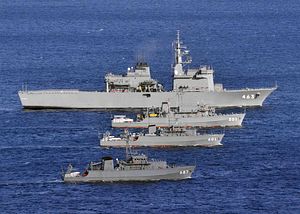In recent remarks, Japanese Defense Minister Tomomi Inada reiterated the Japan Maritime Self-Defense Force’s (MSDF) intention to continue cooperation with the United States in the South China Sea. In a speech delivered at the Center for Strategic and International Studies, a Washington, DC-based think tank, earlier this week, Inada also expressed concerned about China’s behavior in the East and South China Seas.
Inada outlined three particular areas where Japan will continue to deepen its involvement in the South China Sea:
Japan on its part will increase its engagement in the South China Sea through, for example, Maritime Self Defense Force joint training cruises with the U.S. Navy, bilateral and multi-lateral exercises with regional navies, as well as providing capacity building assistance to coastal nations.
“I would like to underline my government’s resolve to protect our territorial integrity and sovereignty,” said Inada. “To this end, we will continue our own defense efforts and also maintain and enhance the Japan-U.S. alliance.”
Inada, newly appointed as defense minister and the second woman to hold that post in Japan, has been described as a potential candidate to succeed Japanese Prime Minister Shinzo Abe.
Japan’s involvement in the South China Sea has drawn China’s attention. Beijing recently warned Tokyo that it would risk China’s wrath by engaging in freedom of navigation patrols (FONOPs) in the region. Ambassador Cheng Yonghua, China’s envoy to Japan, reportedly told Japanese officials that Japanese participation in U.S. Navy-led FONOPs would cross a “red line.”
China has reiterated its operation to Japanese involvement in the South China Sea on other occasions. “We are firmly opposed to Japanese attempts to send its self defense forces to join the so-called Freedom of Navigation operations by the U.S. in the South China Sea,” Colonel Wu Qian, spokesperson for the Chinese Ministry of National Defense, remarked at an August press conference.
Inada, rebuking China’s warnings, declared her support for the U.S. Navy’s ongoing patrols: “In this context, I strongly support the U.S. Navy’s freedom-of-navigation operations, which go a long way to upholding the rules-based international maritime order.” Inada stressed the importance of upholding international law in the South China Sea, saying that if “rule-bending” is permitted to go unchallenged, the “consequences could become global.”
Japan held its first-ever bilateral drill in the South China Sea with the United States Navy last October. Incidentally, this drill took place just days after the United States carried out its first FONOP within 12 nautical miles of Subi Reef and other disputed features in the Spratly Islands. (Subi Reef is the site of one of seven artificial islands constructed by China since 2013.)
Tokyo’s resolve to intensify its maritime involvement in the South China Sea demonstrates the continuing salience of the region for Japanese strategy despite Japan’s lack of geographic proximity to the area. Not only does Tokyo benefit from the preservation of free navigation in the South China Sea, but Japan, as a net importer of fossil fuels, is dependent on open sea lanes across the Asia-Pacific for its energy needs.
































